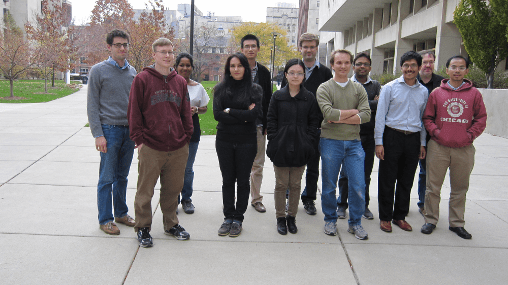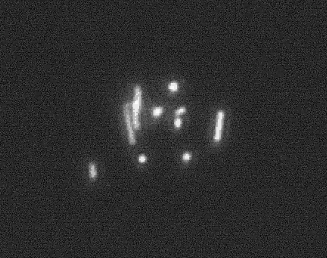Seeing Nature at the Microscopic Scale
Phenomenal events happen at all spatiotemporal scales. We’re particularly interested the physical properties and dynamics of systems that can be observed under a microscope. Our systems of interest range from collections of nanoparticles to vesicles in mammalian cells. The fascinating observations in this regime formulate questions about their underlying physics. To interrogate these questions, we build custom apparatuses, including novel microscopes, and develop simulation methods to measure and understand our systems of interest at the appropriate time and length scales.
Our research interests are wide ranging. See our publications for what’s currently under our microscopes.
Research Areas

Optical Matter
Particles in optical traps interact with one another via scattered electromagnetic fields, and can assemble into stable structures known as Optical Matter. The behavior of optical matter varies widely with the incident field and number of particles.

cellular biophysics
Life at steady state is far from simple. Biological transport can range from Brownian-like to highly driven. Cargo trafficking is an active transport process that undergoes mechanistically complex and varied motion.
Professor Zijie Yan, in memorium


Group Photo at University of Chicago including Zijie Yan, 2014
A Tragic Event
A brief reflection of my and my research group’s intersection in Zijie Yan all too brief life and work that I/we know well.
I have to begin by saying what a kind and pleasant person Zijie was. He was also a very dedicated father. I am most sorry for his wife and children who must be devastated.
Though Zijie was a postdoctoral researcher in my group, I thought of him as a close colleague with whom I could share and discuss ideas and our mutual research without barriers. While this is an ideal one strives for in academia, there are limits with most people. Zijie really enjoyed such interactions and conducted them objectively and with an open mind. He was both creative and rigorous in his work, so we had many discussions and debates over these years (2011-2015) that helped us to progress rapidly in a new science direction we had discovered; creating a new type of material – termed optical matter – that consists of (metallic) nanoparticles bound together by light. By the time of his discovery in 2012 he and I had already written several research papers together on trapping and controlling the position and orientation of nano-objects (e.g., metallic nanowires) in focused optical beams. While our next planned experiment on gold nanowires did not have the desired outcome, I remember well video (shown here) of the optical microscopy measurement that Zijie conducted in 2012 and the unusual behavior of a collection of Au nanospheres that we treated as innocuous “contaminants” in the liquid suspension (i.e., the sample). The nanospheres were persistent in wanting to become ordered groupings that the nearby nanowires were occasionally disrupting. As an analogy, think of (cartoons of) swarming bees that are only transiently deterred by swatting at them. I suggested immediately that the phenomenon that was trying to bring the nanospheres together in the beam of light was aleady known as “optical binding”. Then Zijie was off the the races! Through a series of papers we published, Zijie studied and defined this new type of optical matter material.

After he completed his postdoctoral studies, Zijie began his own independent research program at Clarkson University in New York. I saw how his research flourished and he was combining elements of research that he did as a graduate student at Rensselaer Polytechnic Institute with his PhD mentor, Prof. Chrisey, and what he started in my group. His group and mine also published several papers together over several years (2016-2020) that culminated with the creation of a self-organizing nanoscale optical matter machine (https://schererlab.uchicago.
Over the 12+ years that I have known Zijie, my impression of him has only grown; from a very focused and determined young scientist to one of the most creative colleagues that I know. i enjoyed reading every one of his published papers and have been stimulated by the creative ideas that he has put forth. He was very highly regarded in the photonics and optical trapping scientific communities. From our numerous interactions over the years – both in my group and afterwards – he also showed that he is a generous colleague and person. He helped mentor and collaborate with several graduate students and postdoctorals in my group and later in my discussions with his students, particularly at Clarkson, I was struck by how much they enjoyed being in his research group and respected him as a research advisor. Zijie was a quiet person who was very close to his research group members and helped them to flourish in their doctoral studies and also well prepare them for their future careers. A wonderful person and mentor to remember and emulate.
Norbert Scherer (August 29, 2023)
https://www.nbcnews.com/news/asian-america/zijie-yan-unc-shooting-victim-rcna102511

